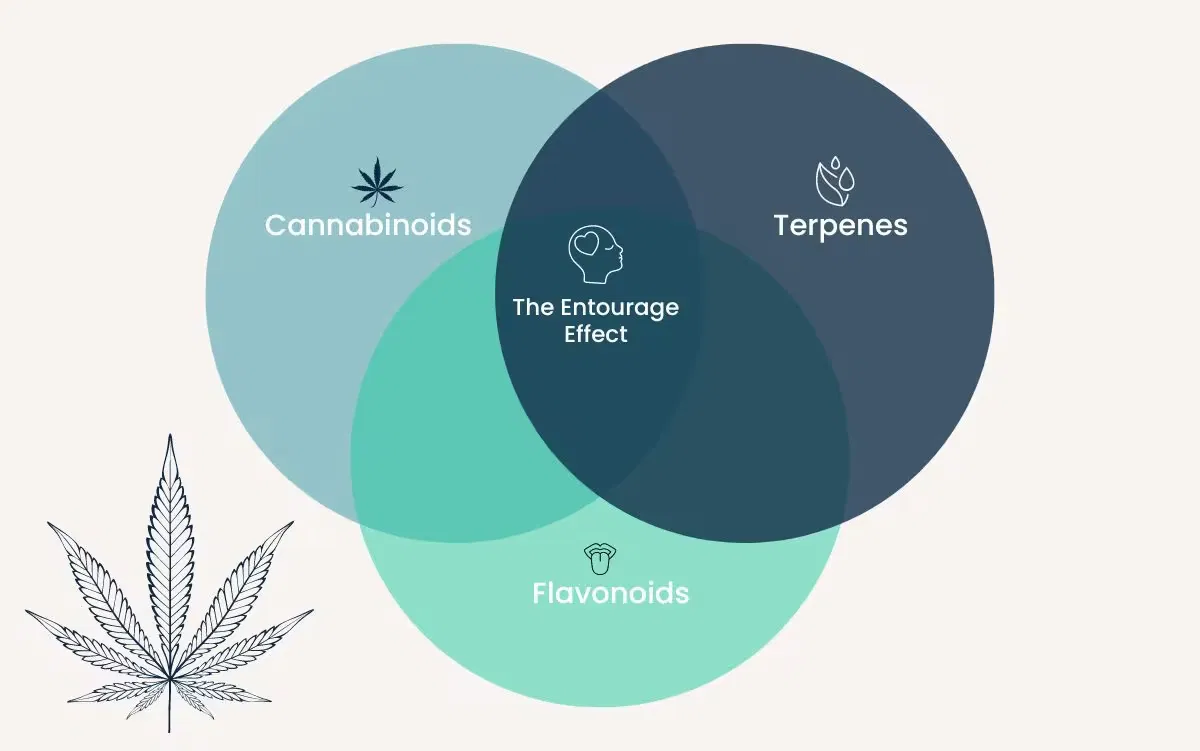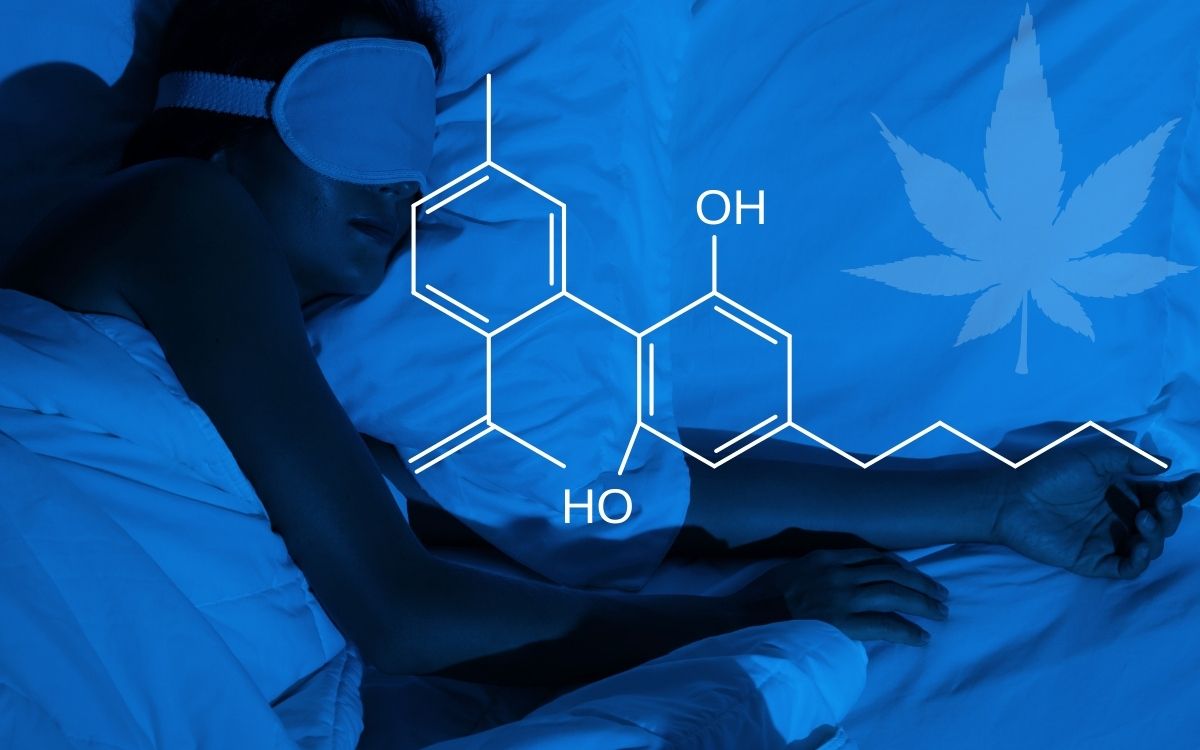
Key Takeaways:
Each cannabinoid plays a unique role. CBD supports calm and recovery, CBN promotes deep sleep, and THC contributes relaxation and relief when carefully balanced.
Together they work better. Learn how the “entourage effect” helps these cannabinoids amplify one another’s benefits — a principle behind Slumber’s advanced sleep formulations.
Natural support for mind and body. Explore research-backed ways CBD, CBN, and THC can help you unwind, sleep soundly, and wake restored — all from a plant-based source.
The term "entourage effect" was first introduced in 1998 by renowned scientists Raphael Mechoulam and Shimon Ben-Shabat. The Entourage Effect is when cannabinoids, terpenes, and flavonoids, work together to produce therapeutic and medicinal benefits in humans. The symphony of components harmonize to produce a stronger, combined result for the end user. Think of this concept as a symphony where all instruments together create a beautiful harmonic exploration of sound and space, whereas the instruments individually cannot produce that same outcome. Put another way, the entourage effect explores how each compound, when combined together, like in Slumber’s Deep Zzzs product, has the potential to create a more desirable, stronger effect.

The entourage effect is all about collaboration between the compounds. Let’s explore how cannabinoids, when combined in the same product, may enhance each other’s benefits:
CBD & THC: Research suggests that CBD might mitigate some of the less desirable effects of THC, such as anxiety or paranoia. By doing so, users may experience the therapeutic benefits of THC with fewer side effects.
CBN & Sleep: While CBN is being studied for its potential sedative effects when combined with other cannabinoids like CBD, the overall sleep-enhancing effect may be amplified.
Terpenes: Beyond cannabinoids, terpenes (aromatic compounds in cannabis) play a vital role in the entourage effect. For instance, linalool, commonly found in lavender and cannabis, might possess potential anti-anxiety and pain-relieving properties. When combined with cannabinoids, these effects might be further enhanced.
A study published in the British Journal of Pharmacology highlighted that certain combinations of cannabinoids and terpenes could be used for several potential therapeutic applications, including pain relief, anxiety control, and even as antiseptic agents.
Furthermore, a review published onNCBI underscores the idea that the effects of whole-plant cannabis extracts are more potent than the sum of their parts, hinting at the immense potential of the entourage effect.
The understanding of the entourage effect may reshape how consumers and patients approach cannabinoid-based products:
Holistic Approach: Instead of seeking isolated cannabinoids, there might be a shift towards products that maintain the integrity of the entire plant. We have also seen a transition and evolution in the “CBD industry,” which indicates that other functional ingredients are combined with whole plant compounds to advance the overall efficacy of products available.
Personalized Medicine: With further research, personalized cannabinoid and terpene profiles can be developed to address specific therapeutic needs. As the industry continues to evolve, there may be an evolution in terpene profile management where the end customers are able to customize and tailor their terpene profiles accordingly.
Safety and Efficacy: As we better understand the interactions between cannabinoids, dosing can be optimized to ensure both the safety and efficacy of cannabinoid-based treatments.
The world of cannabinoids is vast and intriguing, often sparking curiosity and interest from seasoned researchers and the general public related to their benefits. With increasing attention on the potential therapeutic benefits of compounds like CBD (cannabidiol), CBN (cannabinol), and THC (tetrahydrocannabinol), there’s one term that has gained significant traction in recent years: The Entourage Effect.
At Slumber, we want to equip our community with as many health and wellness resources as possible. In this in-depth exploration, we’ll dive deep into the concept of the entourage effect and the compounds represented and explore the benefits of CBD, THC, and CBN using reputable sources and peer-reviewed research studies published both domestically and internationally. We hope to shed light on how each cannabinoid can benefit the general population, and when combined, it might amplify the therapeutic potential of cannabinoids.
It’s important to tell you that statements about CBD, THC, and CBN have not been reviewed by the FDA, and that any information Slumber relays to our community is not meant to diagnose, treat, or cure any disease. If you are unsure whether these compounds are right for you, please consult your primary care physician for a professional opinion.

While cannabis boasts over a hundred different cannabinoids, CBD, CBN, and THC are among the most researched and best understood of the lot. Even though research is growing, emerging, and each compound's efficacy is still being understood, breakthroughs like the Farm Bill are a strong indicator that CBD, CBN, and THC possess therapeutic and medicinal benefits. It is also an indication that the broader society and governmental entities are paying closer attention. Let's take a closer look at each of these compounds:
CBD (Cannabidiol): Known for its therapeutic benefits without the intoxicating effects, CBD has been studied for its potential anti-inflammatory, anxiolytic, and neuroprotective properties. Some of the benefits of CBD have been enabling better sleep, pain and inflammation mitigation, stress and anxiety reduction, and the ability to combat seizures at high dosages. Some of CBD’s most common form factors include tinctures and CBD gummies.
CBN (Cannabinol): Gaining more attention for its sedative effects and benefits for sleep quality and overall sleep time, CBN is the shining star of Slumber's most popular products, such as the Deep Zzzs sleep gummies. Whether CBN is combined with other compounds or not, people often report lower anxiety, a sense of calmness, and the ability to fall asleep easier.
THC (Tetrahydrocannabinol): Famously associated with the “high” of cannabis, THC has an array of therapeutic effects, including pain relief, elevated mood, appetite stimulation, and heightened creativity. One of Slumber’s fastest growing products is the Afternoon Delight – a THC gummy combined with CBD and CBG.
Cannabidiol (CBD), a non-intoxicating compound derived from the Cannabis sativa plant, has taken the health and wellness industry by storm in recent years. While anecdotal accounts tout a range of benefits, you might be asking yourself, "What does the scientific literature actually say?"
In this essay, we’ll dive into peer-reviewed journal articles to explore the documented benefits of CBD, shedding light on this captivating compound. Please keep in mind that we are elevating scientific studies that are published in the United States as well as internationally. Some studies use rodents and human subjects to arrive at the outcomes. While we are still in the very beginning stages of understanding the benefits of CBD, some of this early research we are sharing is compelling. Please also keep in mind that the efficacy of CBD and the benefits of CBD are contingent upon high quality raw materials, extraction process, and supreme quality assurance throughout. The adage that "you get what you pay for" is especially true in the case of CBD. In order to maximize the benefits of CBD, always make sure to purchase from reputable companies who test their products rigorously by an independent laboratory.

One of CBD’s most widely recognized benefits is its potential anti-inflammatory properties. A study published in the Journal of Experimental Medicine found that CBD significantly reduced chronic inflammation and pain in some rodents. Such findings are promising for conditions characterized by inflammation, such as arthritis or chronic pain.
One of CBD’s most widely recognized benefits is its potential anti-inflammatory properties. A study published in the Journal of Experimental Medicine found that CBD significantly reduced chronic inflammation and pain in some rodents. Such findings are promising for conditions characterized by inflammation, such as arthritis or chronic pain.
One of CBD’s most widely reAccording to research, CBD’s interaction with the endocannabinoid system may provide neuroprotective benefits. A study in the British Journal of Clinical Pharmacology indicated that CBD might prevent neurodegeneration related to diseases like Alzheimer’s and Multiple Sclerosis. Again, this is not intended to relay that CBD is able to prevent serious diseases, but our goal at Slumber is to equip you with knowledge and understanding of the potential benefits from early-stage research. Please do not take this as a statement recognizing CBD or any of Slumber’s products as a cure for serious illnesses, but rather another resource to consider when considering your health and wellness routine. We always encourage our community to consult with your medical professional about any supplements you consider incorporating.cognized benefits is its potential anti-inflammatory properties. A study published in the Journal of Experimental Medicine found that CBD significantly reduced chronic inflammation and pain in some rodents. Such findings are promising for conditions characterized by inflammation, such as arthritis or chronic pain.
One of the most groundbreaking discoveries surrounding CBD’s benefits relates to its effect on epilepsy. The New England Journal of Medicine published a clinical trial that demonstrated a significant reduction in the frequency of seizures in patients with Dravet syndrome, a severe form of epilepsy. This led to the approval of Epidiolex, a CBD-based drug, by the U.S. Food and Drug Administration (FDA).
CBD’s potential anti-inflammatory properties might extend to skincare. A study in the Journal of Clinical Investigation found that CBD could regulate the production of sebum, potentially offering therapeutic avenues for conditions like acne. In our opinion, topicals have some promising early research results and overall potential, but we would be remiss if we did not mention that topical benefits are among the least explored in the cannabinoid industry. For any new research findings, we will be sure to update our resources accordingly so that our community has access to the latest research findings available online.
Emerging research also suggests that CBD might play a role in sleep regulation. A study in The Permanente Journal demonstrated that CBD could help increase sleep duration, potentially benefiting those with insomnia or other sleep disorders. Our sleep study also corroborated these findings and showed that CBD, combined with CBN and THC, produced an extra hour of sleep per night as compared to evenings where the Slumber Deep Zzz gummy was not used.
While these findings are promising, it’s crucial to note that many of the studies conducted so far are preliminary. More extensive human trials are required to ascertain the full spectrum of CBD’s benefits. Furthermore, individuals should always consult with a healthcare professional before adding CBD or any supplement to their regimen.
With increasing research and growing interest, the potential benefits of CBD continue to expand. As the scientific community delves deeper into this fascinating compound, it’s evident that CBD might just live up to its celebrated status in the health and wellness realm. One of the next steps in validating CBD’s efficacy sits with the FDA to provide guidance and oversight for the industry to enable companies like Slumber who prioritize high-quality operations, safety protocols, and practices that prioritize our community and those interested in CBD products.

Tetrahydrocannabinol, more commonly known as THC, is frequently associated with the psychoactive effects of cannabis. However, beyond its recreational use, recent scientific inquiries have delved into the potential therapeutic benefits of THC. As a key component of the Cannabis sativa plant, THC's medicinal potential has sparked widespread interest, transforming its perception in the medical and scientific community. Furthermore, many states around the country have recognized the medicinal value of THC, shown by the movement for the legalization of medicinal marijuana in states like Colorado, California, and New York.
Chronic pain affects millions globally, and finding effective treatments has been a challenge for the medical community. A comprehensive review in the Journal of Pain and Symptom Management found that THC can significantly reduce neuropathic pain, offering an alternative to traditional pain relievers. As we think about and observe the domestic issue associated with opioids and pain mitigation, we also recognize that alternatives to pharmaceutical options could play a significant factor for people looking to wean themselves from substances that show addictive properties resulting in more than 80,000 opioid-related overdose deaths in 2021.
One of the well-documented effects of THC is its ability to stimulate appetite. A study in Psychopharmacology demonstrated that THC could effectively enhance appetite and reduce weight loss in patients. The American Cancer Society has published a variety of ways in which THC affects symptoms of cancer patients ranging from reduction of nausea in chemotherapy patients, improved food intake with HIV patients, and the reduction in required pain medication for certain patients.
For patients undergoing treatments like chemotherapy, nausea and vomiting can be debilitating side effects. THC has shown promise as an antiemetic. A peer-reviewed article in the British Journal of Pharmacology highlighted the efficacy of THC in reducing nausea and vomiting for chemotherapy patients. For anyone who has personally dealt with chemotherapy or witnessed a loved one endure chemotherapy cycles, this particular process can result in vomiting, nausea, and a whole host of other symptoms. The British Journal and American Cancer Society both cite THC’s potential in patients experiencing these taxing, enduring, and repetitive cycles of chemotherapy.
Insomnia and sleep disorders affect a large segment of the population. According to research published in the Journal of Clinical Psychopharmacology, THC can increase sleep duration and decrease the frequency of awakenings during the night. This is one of the main reasons why we incorporate a federally legal amount of THC in our cbd productsavailable online.
Emerging research suggests that THC might have neuroprotective qualities. A study in the Journal of Neuroscience Research found that THC could reduce brain damage in animal models, potentially opening avenues for research into conditions like Alzheimer’s disease. Again, this is preliminary research and we want to stress the importance that we pride ourselves on making quality research available to you without making any claims that these compounds will treat or cure any diseases. While the preliminary research is promising, more research needs to be done in order to understand the potential benefits of THC fully.
THC has long been discussed in the context of glaucoma due to its potential to reduce intraocular pressure, a major risk factor for the disease. Research in the Journal of the National Medical Association has shown that THC can provide short-term relief by decreasing intraocular pressure, offering potential adjunctive treatment for glaucoma patients.
While the therapeutic potential of THC is evident from the aforementioned studies, it is essential to acknowledge the side effects and the psychoactive properties associated with its consumption. Medical professionals recommend a balanced approach, considering both the benefits and potential risks. For some, the psychoactive properties of THC are not enjoyable and may induce feelings of anxiety, especially in high doses. We always recommend starting with small doses and optimizing your dose to your desired outcomes.
As the legal landscape surrounding cannabis and THC continues to evolve, more comprehensive studies are anticipated to be conducted, offering a clearer understanding of THC’s full spectrum of benefits. Staying informed and consulting with healthcare professionals is crucial for consumers and patients.
The narrative around THC is shifting. No longer just the compound responsible for the “high” of cannabis, THC is stepping into the limelight as a potential therapeutic agent, ready to redefine its role in the world of medicine. We will continuously look for ways to safely incorporate THC into Slumber’s product line so as to produce products that can safely cater to your needs.

Cannabinol (CBN) may not be as widely recognized as its cannabis-derived counterparts, CBD and THC, but it's steadily gaining traction in the wellness community. Emerging from the shadows of limited research, CBN is being heralded for its unique health benefits. Let's delve into the scientific literature and peer-reviewed studies to understand CBN's therapeutic potential - our star ingredient at Slumber and the basis for our published guide to CBN.
CBN's potential as a sleep aid has been one of its standout characteristics. Preliminary research suggests that CBN can promote longer and more restful sleep as was proven in Slumber's at home sleep study where participants reported falling asleep easier, waking up less frequently during the night, and even getting an average of 72 extra minutes of sleep per night when taking Deep Zzzs sleep gummies. Though more extensive studies are needed, and we will be relentlessly supporting the advancement of CBN studies, this finding positions CBN as a promising alternative for those grappling with sleep disorders and for anyone who wants an alternative to melatonin.
The anti-inflammatory benefits of cannabinoids have been a subject of interest for researchers. A study published in the European Journal of Pharmacology discovered that CBN could be a potent anti-inflammatory agent, offering potential therapeutic benefits for conditions characterized by inflammation.
Remarkably, CBN has demonstrated efficacy as an antibacterial agent. Research from the Journal of Natural Products found that CBN was effective against various antibiotic-resistant bacterial strains. As antibiotic resistance emerges as a global health concern, findings like these suggest that CBN might play a crucial role in developing new treatments.
While THC is often lauded for its appetite-stimulating effects, recent studies indicate that CBN might offer similar benefits without the psychoactive side effects. Preliminary research conducted on rodents found that CBN increased food intake, suggesting its potential as an appetite stimulant[^4^].
The neuroprotective qualities of cannabinoids have been a pivotal research area, and CBN is no exception. Early studies indicate that CBN may offer neuroprotection, which could have implications for conditions like Alzheimer's disease. Further studies are needed to fully understand the true medicinal benefits of CBN.
Navigating the maze of cannabinoid research can be challenging, given the rapidly evolving landscape. As previously stated, our hope is for the FDA to provide detailed guidance on the use of cannabinoids such as CBN in a timely and effective manner. Still, the therapeutic promise of CBN stands out. As research deepens and becomes more refined, it's anticipated that the full spectrum of CBN's benefits will emerge, further cementing its place in the wellness and medical communities.
For those curious about the potential of CBN, it's vital to stay updated with current research and consult healthcare professionals before integrating it or any cannabinoid into a wellness regimen. CBN's journey is just beginning. As it transitions from a lesser-known cannabinoid to a potential therapeutic powerhouse, the future looks promising for this intriguing compound. We will continue identifying ways to incorporate CBN into our product catalog safely.
At Slumber, our mission is not only to offer high-quality cannabinoid products but also to educate and inform our community. As the landscape of cannabinoid research expands, we are dedicated to staying at the forefront, ensuring our community is well-informed and empowered.
Our commitments:
Quality Driven: We source the highest quality, whole-plant extracts to ensure you get the full benefits of the entourage effect.
Pioneering Education: Our platform continuously offers insights grounded in the latest research, ensuring you make informed decisions.
Transparency for Consumers: Every product is third-party lab tested, guaranteeing its safety and potency, and
are available on our website and updated regularly.
Slumber's Deep ZZZ's gummies are expertly formulated without melatonin and 3mg THC, 25mg CBD, and 8mg CBN to promote sleep within 30-60 minutes of consumption.
Customers love the delicious lemon raspberry flavor and use of only vegan ingredients, Deep Zzz's are one of the most potent and tasty CBD sleep aids on the market.
Great taste
Available online and ships to 49 states (Not Colorado)
Doctor approved and recommended
30-Day Money Back Guarantee
Shop now - $60.00
The entourage effect, a harmonious interaction between cannabinoids, terpenes, and other cannabis compounds, represents the future of cannabinoid research. It underscores the idea that nature, in its wisdom, has woven a complex tapestry of compounds that, when working together, produce effects greater than the sum of their parts.
At Slumber, we remain committed to harnessing this wisdom, ensuring every product we offer resonates with the symphony of the entourage effect. Stay curious, stay informed, and trust Slumbner to be your guide in the world of cannabinoids

Dr. Jim Giltner, MD
Ophthalmologist, 36 of years of medical practice
References:
Mechoulam, R., & Ben-Shabat, S. (1998). From gan-zi-gun-nu to anandamide and 2-arachidonoylglycerol: the ongoing story of cannabis. Natural Product Reports.
Blessing, E. M., Steenkamp, M. M., Manzanares, J., & Marmar, C. R. (2015). Cannabidiol as a Potential Treatment for Anxiety Disorders. Neurotherapeutics.
Russo, E. B. (2007). History of cannabis and its preparations in saga, science, and sobriquet. Chemistry & Biodiversity.
Whiting, P. F., Wolff, R. F., Deshpande, S., Nisio, M. D., Duffy, S., Hernandez, A. V., ... & Kleijnen, J. (2015). Cannabinoids for medical use: A systematic review and meta-analysis. JAMA.
Zuardi, A. W., Hallak, J. E., & Crippa, J. A. (2012). Interaction between cannabidiol (CBD) and ∆9-tetrahydrocannabinol (THC): influence of administration interval and dose ratio between the cannabinoids. Psychopharmacology.
Russo, E. B. (2011). Taming THC: potential cannabis synergy and phytocannabinoid‐terpenoid entourage effects. British Journal of Pharmacology.
Baron, E. P. (2018). Medicinal properties of cannabinoids, terpenes, and flavonoids in cannabis, and benefits in migraine, headache, and pain.
Benefits of CBD References:
Costa, B., Trovato, A. E., Comelli, F., Giagnoni, G., & Colleoni, M. (2007). The non-psychoactive cannabis constituent cannabidiol is an orally effective therapeutic agent in rat chronic inflammatory and neuropathic pain. Journal of Experimental Medicine.
Bergamaschi, M. M., Queiroz, R. H., Chagas, M. H., de Oliveira, D. C., De Martinis, B. S., Kapczinski, F., ... & Crippa, J. A. (2011). Cannabidiol reduces the anxiety simulated public speaking induces in treatment-naïve social phobia patients. Neuropsychopharmacology.
Schier, A. R., Ribeiro, N. P., Silva, A. C., Hallak, J. E., Crippa, J. A., Nardi, A. E., & Zuardi, A. W. (2014). Antidepressant-like and anxiolytic-like effects of cannabidiol: a chemical compound of Cannabis sativa. Journal of Chemical Neuroanatomy.
Iuvone, T., Esposito, G., Esposito, R., Santamaria, R., Di Rosa, M., & Izzo, A. A. (2004). Neuroprotective effect of cannabidiol, a non-psychoactive component from Cannabis sativa, on β-amyloid-induced toxicity in PC12 cells. British Journal of Clinical Pharmacology.
Devinsky, O., Cross, J. H., & Wright, S. (2017). Trial of Cannabidiol for Drug-Resistant Seizures in the Dravet Syndrome. New England Journal of Medicine.
Oláh, A., Tóth, B. I., Borbíró, I., Sugawara, K., Szöllõsi, A. G., Czifra, G., ... & Bíró, T. (2014). Cannabidiol exerts sebostatic and antiinflammatory effects on human sebocytes.
Benefits of THC References:
Wilsey, B., Marcotte, T., Deutsch, R., Gouaux, B., Sakai, S., & Donaghe, H. (2013). Low-dose vaporized cannabis significantly improves neuropathic pain. Journal of Pain and Symptom Management.
Haney, M., Rabkin, J., Gunderson, E., & Foltin, R. W. (2005). Dronabinol and marijuana in HIV+ marijuana smokers: Acute effects on caloric intake and mood. Psychopharmacology.
Parker, L. A., Rock, E. M., & Limebeer, C. L. (2011). Regulation of nausea and vomiting by cannabinoids. British Journal of Pharmacology.
Cousens, K., & DiMascio, A. (1973). (-) Delta 9 THC as an hypnotic. An experimental study of three dose levels. Journal of Clinical Psychopharmacology.
Fishbein-Kaminietsky, M., Gafni, M., & Sarne, Y. (2014). Ultralow doses of THC protect the brain from neuroinflammation-induced cognitive damage. Journal of Neuroscience Research.
Merritt, J. C., Crawford, W. J., Alexander, P. C., Anduze, A. L., & Gelbart, S. S. (1980). Effect of marihuana on intraocular and blood pressure in glaucoma. Journal of the National Medical Association.
Benefits of CBN References:
Mahadevan, A., & Siegel, C. (2009). The role of cannabinoids in sleep and wake regulation. Journal of Clinical Sleep Medicine.
Zurier, R. B., & Burstein, S. H. (2016). Cannabinoids, inflammation, and fibrosis. European Journal of Pharmacology.
Appendino, G., Gibbons, S., Giana, A., Pagani, A., Grassi, G., Stavri, M., Smith, E., & Rahman, M. M. (2008). Antibacterial cannabinoids from Cannabis sativa: a structure-activity study. Journal of Natural Products.
Farrimond, J. A., Whalley, B. J., & Williams, C. M. (2012). Cannabinol and cannabidiol exert opposing effects on rat feeding patterns. Psychopharmacology.
Hampson, A. J., Grimaldi, M., Axelrod, J., & Wink, D. (1998). Cannabidiol and (-)Δ9-tetrahydrocannabinol are neuroprotective antioxidants. Proceedings of the National Academy of Sciences.